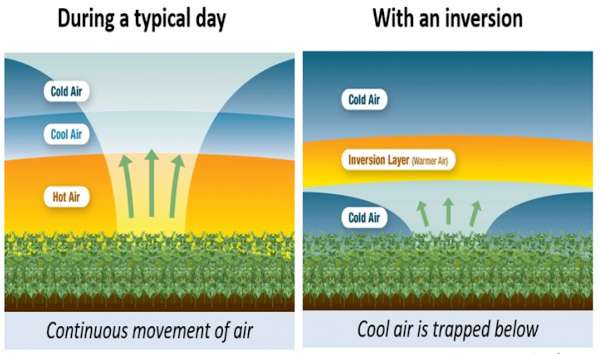By Terry Basol
Temperature Inversions
It is never recommended to spray a pesticide when a temperature inversion exists, and many labels provide guidelines to follow in order to avoid applications during one. This blog will discuss what temperature inversions are, why they can be dangerous for pesticide applications, and how to identify when temperature inversions are happening.
For example, dicamba products labeled for over-the-top applications in soybean include some of the most specific guidelines. These include making sure that applications occur between one hour after sunrise and 2 hours before sunset, as well as ceasing applications when wind speed is less than 3 miles per hour at boom height. In normal conditions, the sun warms the earth’s surface. As the surface air temperature increases, it rises and the wind mixes it with the cooler air above it (allowing for dispersion of spray droplets in the atmosphere). A temperature inversion is opposite of that, where a layer of warm air is trapped between cooler air higher in the atmosphere and dense cooler air close to the earth’s surface as a result of less solar intensity at the end of the day (Figure 1). This warm air layer (inversion layer) prevents upward movement of the cool surface layer, creating very stable conditions.
If an application occurs during a temperature inversion, small droplets are ‘trapped’ in the air above the ground and can move across the landscape. According to John Nowatzkl, NDSU extension agricultural machine systems specialist, “If pesticides are applied during an inversion, small droplets readily can move thousands of feet before falling to the ground. In addition, some pesticides volatize, or change from liquid to vapor. Vaporized pesticides can move miles from the application site during a temperature inversion.” (Excerpt taken from “Understanding Air Temperature Inversions Relating to Pesticide Drift”; publication AE1876 – Click on link below to download)
Temperature inversions usually begin to form at the end of the day around dusk (3-5 hours before sunset) and last through the evening (intensifying throughout the night) up to sunrise. As the sun warms the earth’s surface in the morning and the air mixes, the inversion will dissipate thereafter (usually 2-3 hours after sunrise).

Figure 1. Development of a Temperature Inversion.
Conditions that Most Likely Favor Temperature Inversions